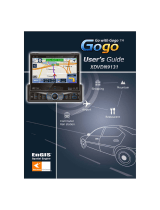14
Planning a route in advance
You can use your ONE/XL to plan a route in advance, selecting your starting
point and your destination.
Here are some more reasons to plan a route in advance:
• Find out how long a journey is going to take before you start.
You can also compare journey times for the same route at different times of
the day or on different days of the week. Your TomTom ONE/XL uses IQ
Routes when planning a route. IQ Routes calculates routes based on the real
average speeds measured on roads.
• Study the route of a journey you are planning.
• Check a route for someone who is coming to visit you and then explain the
route to them in detail.
To plan a route in advance, follow these steps:
1. Tap the screen to bring up the main menu.
2. Tap the arrow button to move to the next menu screen and tap Prepare
route.
3. Select the starting point for your journey in the same way that you would
select your destination.
4. Set the destination for your journey.
5. Choose the type of route that should be planned.
• Fastest route - the route which takes the least time.
• Shortest route - the shortest distance between the locations you set. This
may not be the quickest route, especially if the shortest route is through
a town or city.
• Avoid motorways - a route which avoids motorways.
• Walking route - a route designed for making the journey on foot.
• Bicycle route - a route designed for making the journey on a bicycle.
• Limited speed - a route for a vehicle which can only be driven at a limited
speed. You have to specify the maximum speed.
6. Choose when you will make the journey you are planning. There are three
options:
• Now
• Specific date and time - you will be asked to enter the date and time.
• No specific date and time
If you select either Now or Specific date and time, your ONE/XL uses IQ
Routes to work out the best possible route at that time, using the real
average speeds measured on roads. In this way you can compare how long
a journey takes at different times of day, or on different days of the week.
Position of
last stop
Tap this button to select your last recorded position, as your destination.
Prepare route





















